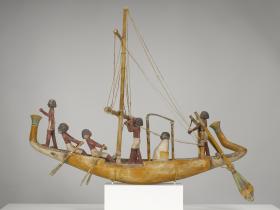Prep
• Drill a hole in the center of each boat to attach the mast (wooden dowel)
• Cut canvas into right triangles for sails
• Cut small slits into top and bottom of each “sail” so the “mast” can be inserted
Set Up
• At each student’s place, set a 4 x 6’ piece of wood and wood dowel with canvas
• Have markers ready in tubs for distribution.
Introduction/ Warm-Up
- Ask students to describe boats they have seen. What size were they? Show students pictures of large, life-size boats. Then show them a toy boat. How do these boats compare to the one in the image of Model of a Boat?
- Ask the students why they think the sculpture is called a model. Brainstorm what a model might be used for.
- Tell students they will be making their own models of boats from wood.
- Ask students to point out the shapes they see in Model of a Boat.
Focus Activity Procedure
- Show students three items they will use to make their sculpture (wood base, dowel, and canvas).
- Demonstrate how to glue the mast onto their boat by putting a few dots of glue into the hole on their boat base and then sticking the mast in.
- Wipe up any glue that spills over with a paper towel.
- Next, show students how to insert the canvas sail onto the mast.
- Once their boat is assembled, they can decorate. Tell students the markers they will use are permanent markers. This means that the marks will not come out of clothing and they should only use them on their boats. They need to be very careful. Students can decorate their boats however they like. Encourage them to think of a fun name for their boat.
- Students need to write their own name on their boat, too! (teacher can help)
- When students are finished, they should leave their boat at their table to continue drying, clean up, wash hands, and transition to closing.
Closing
- Clean up.
- Gather class for closing conversation. Ask: Are your boats smaller or larger than a real sailboat? Are they smaller or larger than the toy sailboat? Why are we calling these boats models?
- Walk around to look at everyone’s model boats.
- As students are working, ask them to describe the size and shapes of their model boats to assess knowledge.
- Assess students’ understanding of scale during closing conversation.
sculpture
Egypt
model
float
mast
sail
sailboat
4 x 6” (approx) wood scraps (can usually be donated from high school or college wood shop classes, hardware store, or cabinetry shops),
nontoxic tacky glue (extra thick)
nontoxic Sharpie markers
1/4” wood dowel
canvas cloth, cut into right triangles (sails)
drill with 1/4 drill bit
scissors (for teacher)
images of sailboats
other types of boats
a toy boat (preferably a sailboat)
Extension Activities for Teachers
- Poll the class to find out how many think their boat will float in the water table. Make a graph to chart the results.
- Once the boats are completely dry (24–48 hours), students can experiment with the water table to find out if their predictions were accurate.
Suggested Books for Classroom Library
Cole, Henry. On the Way to the Beach. HarperCollins/Greenwillow, 2003. [ISBN 978-0-688-17515-3]
Lee, Suzy. Wave. Chronicle Books, 2008. [ISBN 978-0-8118-5924-0]
Lionni, Leo. On My Beach There Are Many Pebbles. HarperCollins/Mulberry, 1994, 1961.[ISBN 978-0-7587-9901-2]
McCloskey, Robert. Time of Wonder. Viking, 1985. [ISBN 978-0-670-71512-1]
Schertle, Alice. All You Need for a Beach. Illustrated by Barbara Lavallee. Harcourt/SilverWhistle, 2004. [ISBN 978-0-15-216755-4]
Williams, Karen Lynn. A Beach Tail. Illustrated by Floyd Cooper. Boyds Mills, 2010. [ISBN978-1-59078-712-0]
Zolotow, Charlotte. The Storm Book. Illustrated by Margaret Bloy Graham. HarperTrophy, 1980. [ISBN 978-0-7587-0149-7]


During the Middle Kingdom, tombs often contained models of boats for the deceased to use in a journey across water, a trip necessary to achieve resurrection in the afterlife. With its round bottom and prow and stern in the shape of stylized papyrus, this model boat resembles actual boats used on the Nile. A pilot at the prow watches the river ahead, and a helmsman with two oars steers from the stern. Two sailors attend the rigging for the sail, while four rowers pull on their oars. The deceased, covered in a white garment, sits impassively under a canopy viewing his progress toward the afterlife.


